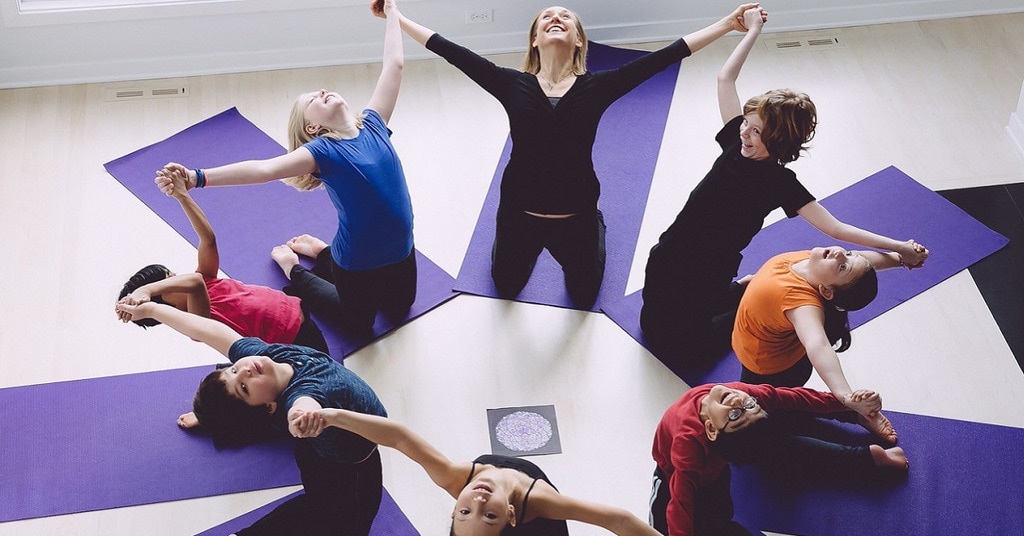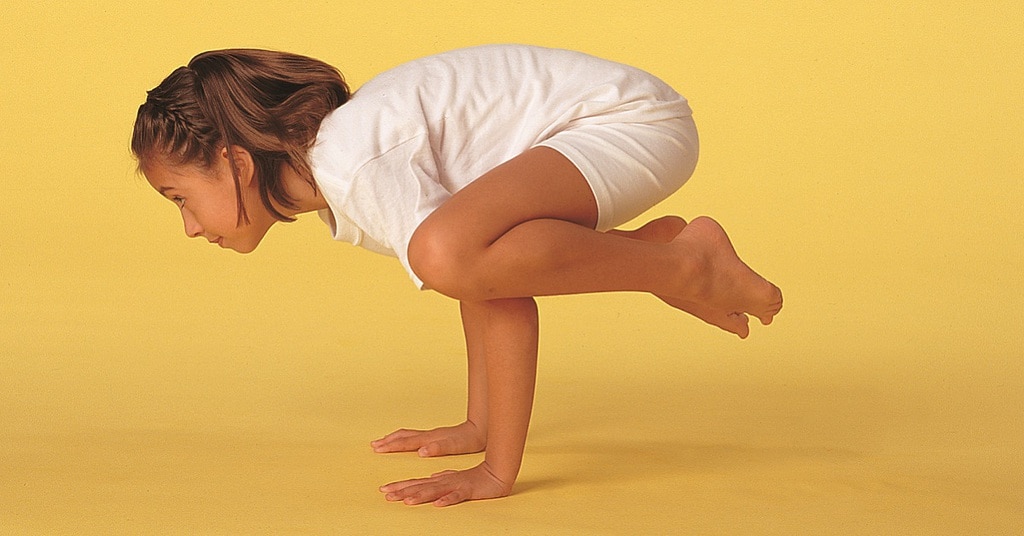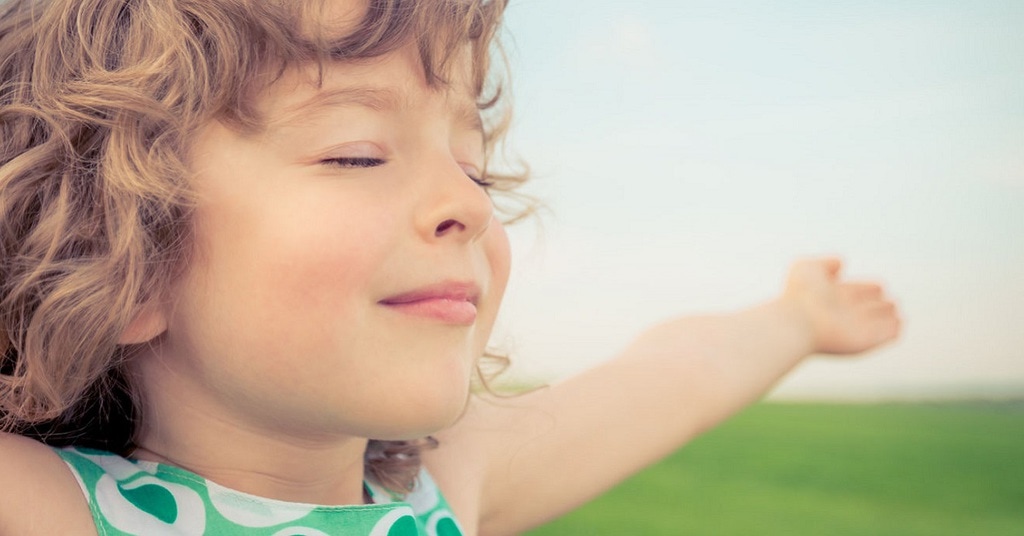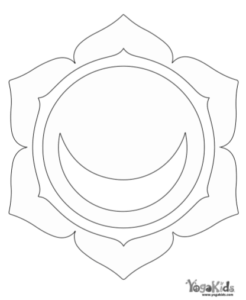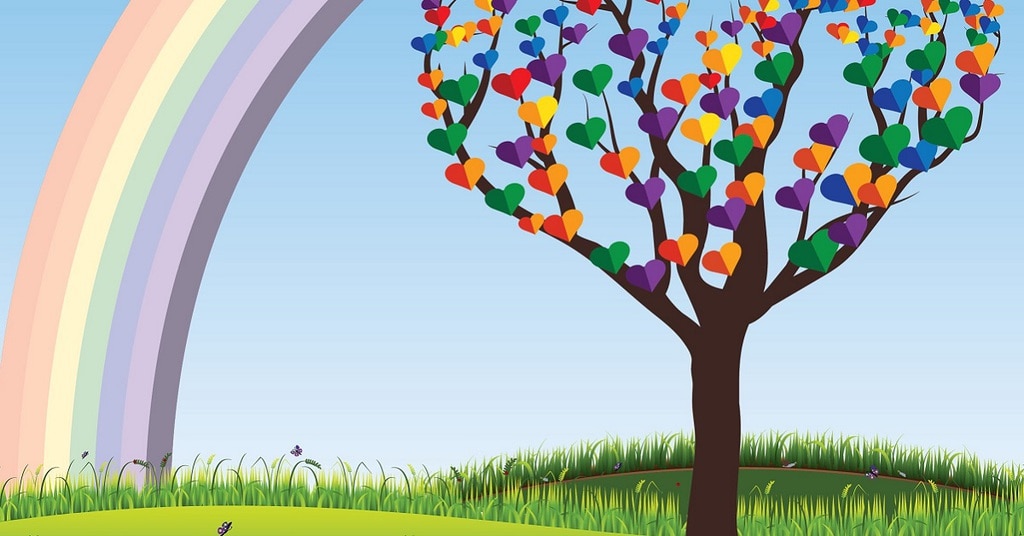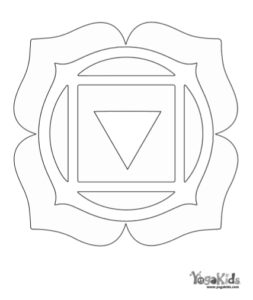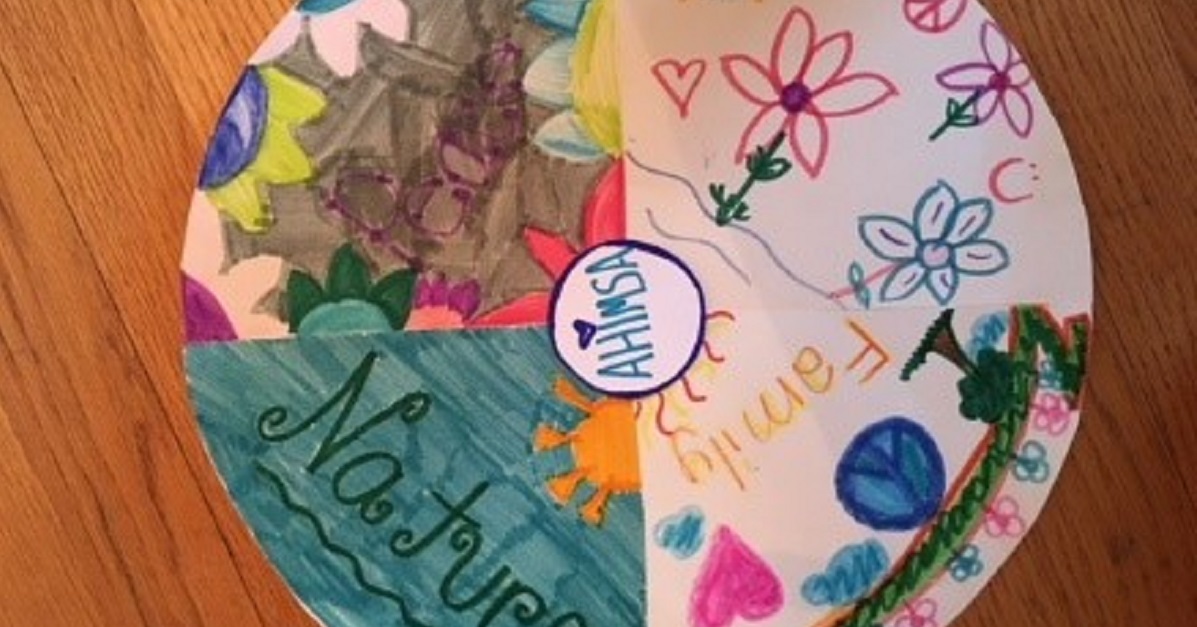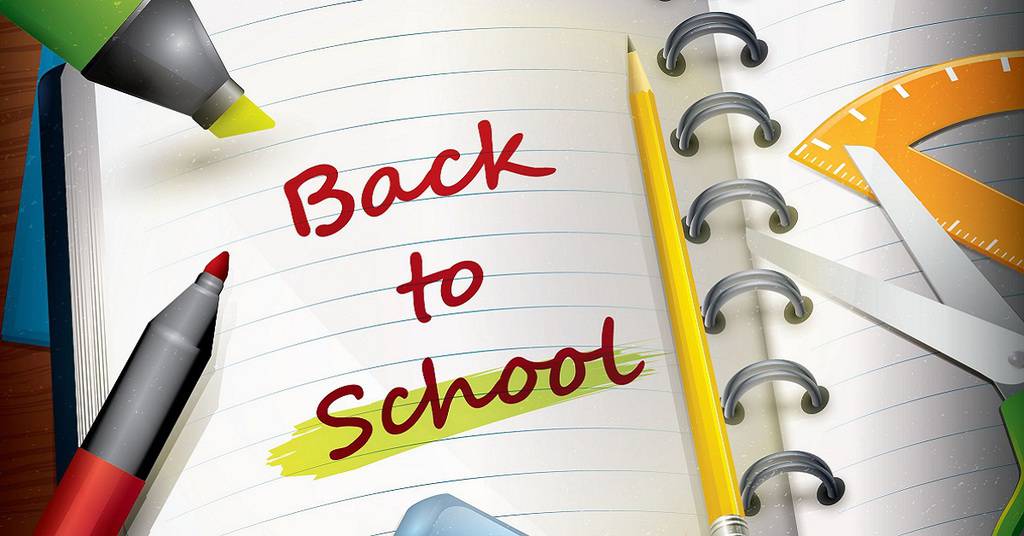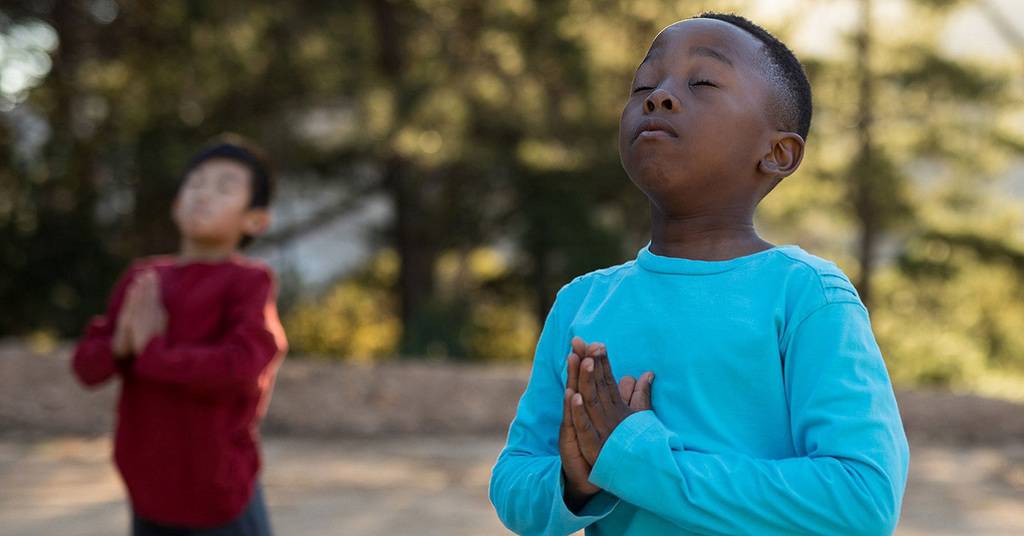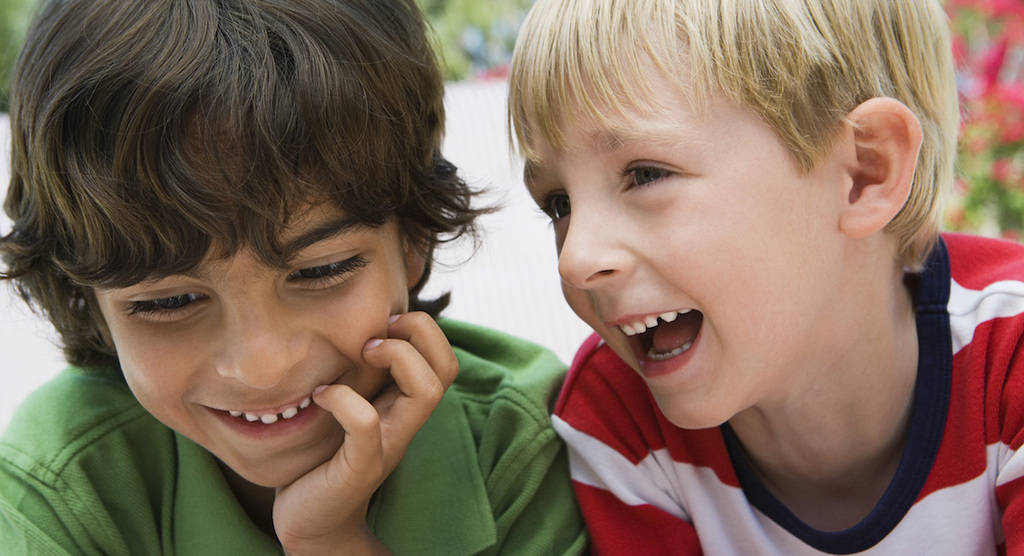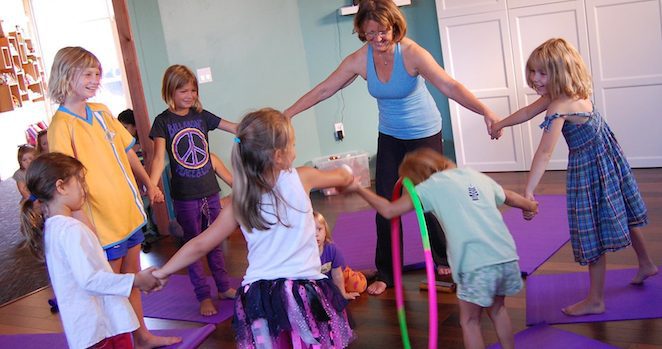MATERIALS
- Markers
- Rocks
- Paper fire
- Firefly templates
- Glue sticks
- Music for savasana
- Breathing buddies
SHORT DESCRIPTION/TOPIC
Explore our national parks and the great outdoors.
CONNECTING CIRCLE
Affirmations
- I will stay on my mat.
- I will keep my hands and my feet to myself.
- I will always do my best.
POSES AS PATHWAYS/INTEGRATE THE ELEMENTS
Sunrise, Sunset – The sun has risen on our summer vacation.
Sit on your heels. Open and close your wings several times. Then open your wings and interlace your fingers above your head. Stretch your arms up as you lift your buttocks off your heels with an inhalation. Exhale and drop your hips to the right as the arms drop left like the setting sun. Inhale and arch your arms overhead like the rising sun. Then, drop your arms to the right as the hips drop left. Repeat.
Yawn and Flop
Stand in Mountain pose. Yawn as you stretch your arms upward with a big yawning sound and then flop forward in Rag Doll. Repeat several times.
Moo and Meow – Let’s kiss the cat good morning.
Begin in All Fours Pose. Line up your wrists under your shoulders. Spread your fingers wide and arch your spine to the sky. Loosen your neck and drop your head down. Breathe out long as you meow. Now lift your chest forward and look up with big cow eyes. Dip your belly down and tilt your sitting bones up. Your back will sink down like a cow’s. Make cow lips and moo deeply from the back of your throat. Go back and forth, meowing and mooing.
Down Diggety Doggie Down – And greet our dog.
Begin in All Fours pose. Bend your toes forward. Spread your fingers wide. Press your doggy paws and heels downward as you lift your hips and tail to the sky. Lengthen your spine. Stretch your arms and legs as long as possible. Let your head hang down. Growl, yawn, bark, and make other doggy sounds. Bend your knee and rotate your belly and chest upward as you raise one leg up and “mark your territory.” Lift your opposite leg too. Be sure to keep your hands pressing downward and your arms straight.
READING COMES ALIVE WITH YOGA
Below is a list of National Parks from A to Z, and the poses are in bold.
Acadia (Maine)
Row, Row, Row Your Boat – Most of the park is on an island!
Begin in L-Sitting pose and place both hands, palms down, alongside your hips. Lengthen your arms and spine. Lean back and lift your legs up. Balance. Stretch your arms forward, palms up. Breathe in and out. Row your arms forward. Reverse, and row your arms backward. Try the pose while singing “Row, Row, Row Your Boat.”
Big Bend (Texas)
Eagle – Big Bend has more kinds of birds than any other park!
Begin in Mountain pose. Lift your right leg and wrap it over your left leg. If you can, hide your right foot and toes behind your left calf. Bring your bent arms up in front of you and place the right elbow on top of your left. Twist together your forearms bringing your palms together. You can also interlace your fingers. Bend your knees. Untangle yourself and change sides, bringing your left leg over your right leg and your left elbow on top of your right. Try to balance for 10 seconds on each side and gradually increase the time. Use a focus friend if you need guidance.
Crater Lake (Oregan)
Waves – Crater lake is the deepest and bluest lake in the United States – 2000 feet deep
Sit on the ground and bend your knees, placing your feet on the floor hip-distance apart. Move your knees and legs back and forth to the left and right, as they ebb and flow like waves. Use this as a transition pose between the wet poses. It is a fun and accessible hip opener.
Dry Tortugas (Florida)
Talking Turtle – Almost all of the park is under water!
Everglades (Florida)
Crocodiles (Alligator Pose) – This is the home to many crocodiles! Did you know? Crocodile’s snout is pointed and V-shaped, and the alligator’s is wide and U-shaped.Alligators are only found in parts of the US and China, whereas crocodiles can be found across the world. Crocodiles prefer water that is more saline or salty than the alligator’s preferred freshwater habitat. Crocodiles can’t hide their teeth, but alligators’ teeth are sometimes hidden when their mouths are closed.
Lie down on your belly. Stretch your arms in front of you, one palm on top of the other. Open and close your arms like a jaw. Open and close your real jaw as you do this, too. Keep your legs together and lifted like an alligator’s tail. Gently bring your tail up and down.
Key Nifords (Alaska)
Pigeon Series – Almost half the park is covered in ice, and is home to many species of birds!
Begin in Down Diggety Doggy Down. Bring one knee forward and place it between your hands. Lower your hips and keep them aligned. Inhale and lift your chest. Exhale and tuck in your chin. On your next inhalation, walk your hands and chest forward. If possible, come all the way down to the floor. Rest here for a moment. Then walk your hands back toward your body until they align under your shoulders. Lift your chest. Bend your knee, foot pointed towards the ceiling. If possible take a hold of your foot or ankle with one or both hands. Return to Down Diggity Doggie Down and repeat on the other side.
Grand Canyon (Arizona)
Squirrel (Dromedary Delight) – If you’re at the bottom, it’s a whole mile to the top. Look up like a squirrel!
Kneel on the floor with your legs and knees hip-width apart. Curl your toes, push your thighs forward, and bring your hands to your lower back. Lift your chest. Breathe evenly in and out as you extend your rib cage and broaden your chest. Continue to lift your chest with each breath as you bring your hands to your heels. Increase the duration and repetitions of the pose as your spine and chest become more flexible. Rest in Child’s Pose after each back-bend.
Hawaii Volcanoes National Park (Hawaii)
Volcano – Lava erupts from the volcano and rushes down to the sea!
Begin in Mountain pose. Bring your fingertips together at the chest. Jump your feet apart. Place your palms together at the center of your body in Namaste Position. Breathe in. Watch your hands as you raise them over your head. Breathe out as you explode your arms outward. Lower them to your sides and return your hands to Namaste. Erupt and release again and again. Make big, exploding volcano noises. Jump your feet back together when you’ve finished erupting.
Isle Royale National Park (Michigan)
Wolf (Up Uppity Doggie Up)- Timber wolves run across frozen lake superior to this park!
From Down Diggety Doggie Down, drop your hips and lift your chest forward with an inhalation. Drop your shoulders away from your ears, broaden your chest and keep your arms strong. Keep your legs up from the floor if you can.
Joshua Tree National Park (California)
Half Moon – The trees as Joshua Tree are as old as 800 years, named after Joshua in the bible, like Joshua the branches seem to be pointing the way to heaven!
Stand in Mountain. Raise your arms overhead and do a side stretch. Switch sides. Repeat.
Sequoia and Kings Canyon (California)
Tree/Leaf – This is the home of the worlds biggest tree, General Sherman!
Begin in Mountain Pose. Lift one foot and press your foot against the inside of your other leg. You can use your hand to place your foot anywhere between your ankle and inner thigh. Avoid the knee joint. As your balance gets stronger, you’ll be able to raise your foot higher up your leg. Bring your hands to your chest, palms together in Namaste position. Then raise your arms up above your head. Stretch them out wide, like the branches of a tree. Separate your fingers. Balance and breathe. Now repeat on the other side.
Lake Clark (Alaska)
Bubble Fish – There’s so much salmon in the water, sometimes the water looks red!
Lie on your back with your arms at your sides. Bring the bottoms of your feet together and open your knees outward. Press your feet together and flop your legs up and down. Slide your hands, palms down, underneath your backside. Squeeze your shoulders together. Arch your back as your chest lifts off the floor. Place the top of your head on the floor. Feel your gills open and close as you breathe. Make fish lips and blow bubbles. Imagine you have gills instead of lungs.
Mesa Verde (Colorado)
Ladder to the Clouds – There are stone cities here that have been empty for 700 years!
Stand tall. Reach up and begin to climb a very tall, imaginary ladder. Reach with your right arm while bending your left leg. Then reach with your left arm while bending your right leg. Keep climbing higher and higher. Climb all the way to the clouds and beyond.
North Cascades (Washington state)
Bunny Breath – This is the home of half of the glaciers in the lower 48 states. The snow shoe rabbit gets its name from its thick padded paws allowing it to walk on snow!
Get comfortable in a seated pose. Make your neck and back as long as you can, tucking in your chin slightly and letting your lower jaw relax. Take short, quick breaths in through your nose. Twitch your nose like a bunny. Then breathe out through your mouth with a long, smooth sigh. Repeat. Increase the number of inhalations and double the length of your exhalations as your breath power gets stronger.
Olympic (Washington state)
Raindrops (Finger Dancing) – Here it rains 12-14 feet a year!
Sit on your heels or cross-legged. Begin at the top of your head and gently stimulate your hair and skin by lightly dancing your fingers all the way down your body. Allow the self-touch to feel good, as it wakes you up, stimulates your skin and lymph system and makes you feel alive. Do this technique along with Salutations to Me. Each time you touch a part of your body say a silent affirmation or kind statement to that place: toes; skull, hair, face, ears, neck, throat, chest, breasts, belly, butt, legs, arms, feet, etc.
Petrified Forest (Arizona)
Lizard – The trees here turn into rocks! Let’s play on the rocks like lizards!
Lie on your belly. Place your hands under your shoulders. Spread your fingers out like lizard claws. Bend your lizard toes forward. Push up until your arms and legs are straight in Plank Pose. Draw your shoulders back and away from your ears. Walk like a lizard, slowly and carefully.
Queens Chamber (New Mexico)
Bat (Butterfly with Antennae) – This place has 700 feet deep caves!
Begin in L-Sitting pose. Bring the bottoms of your feet together, with your heels close to your body and your knees out to each side. Stretch your neck and the top of your head toward the sky and make your spine longer. Place your hands at the sides of your head and stick up your pointer fingers to make antennae. Pull your arms back like they’re your wings. Breathe in and out as you flap your wings forward and back, up and down.
Rocky Mountain (Colorado)
Big Horn Sheep (Lunges) – The symbol of the park is: big horn sheep!
Begin in Down Diggety Doggie Down. Step one foot forward into a lunge and place your hands on either side of that foot. Put your hands onto your upper thigh, above the knee. Breathe in and lift your chest. Breathe out and move your lower body toward the floor. Place your hands back down on the floor and step your foot back. Transform to Down Diggety Doggy Down and repeat on the other side.
Smoky Mountains (North Carolina and Tennessee)
Deer – The smokey haze over the park are the vapors given off the plants and mixing with the warm gulf air!
Sit on your heels. Drop your hips to the left. Cross your right foot over your knee and place it on the ground next to the outside of your left thigh. Your right knee is up. Slide your left foot to the outside of the right hip. Place your hands on either side to support yourself as you lift your chest, lengthen your spine, and twist slightly. Turn your head from side to side. Open your eyes wide like an alert deer. Then switch sides by reversing your legs.
Grand Teton (Wyoming)
Mountain – Rocky mountains are a beautiful jagged wall of granite!
Stand with your feet together or hip-width apart, whichever is most comfortable. Arms are at your sides, fingers stretching towards the floor. Press your feet into the ground. This downward action through the legs allows the torso, neck, and head to rise like a mountain above the clouds. Notice how tall and light you feel.
Upheaval Dome (Utah)
Comet (Swinging Pretzel – There’s a big hole in the ground caused by a meteorite, such as an asteroid or a comet, that originates in outer space and survives its impact with the Earth’s surface!
Sit cross-legged. Place your left ankle and foot high up on your right thigh.Place your right ankle and foot high up on your left thigh. Spread your fingers on the floor just behind your knees. Lift your bottom and legs up off the floor. With strong arms and breathing, swing your pretzel back and forth. Be sure to switch legs so that each gets a turn on top.
Virgin Islands
Jabberwocky Jellyfish or Squid – Explore the nature trail for snorkelers with buoys leading the way!
Sit on your left hip with your left thigh parallel to the front of your mat and your left shin aligned with the side of your mat. Your leg is in the form of a right angle. Twist in the direction of your knees and come forward onto your elbows. Let your upper body come all the way down. Move your fingers and toes as you feel your body moving through the water like a squid. Can you speak Jabberwocky like Lewis Carroll, the author of Alice in Wonderland? Make up some jellyfish jibberish.
Wind Cave (South Dakota)
Tunnels (Down Diggety Doggie Down) – This place has over 100 miles of narrow tunnels!
Begin in All Fours pose. Bend your toes forward. Spread your fingers wide. Press your doggy paws and heels downward as you lift your hips and tail to the sky. Lengthen your spine. Stretch your arms and legs as long as possible. Let your head hang down. Growl, yawn, bark, and make other doggy sounds. Bend your knee and rotate your belly and chest upward as you raise one leg up and “mark your territory.” Lift your opposite leg too. Be sure to keep your hands pressing downward and your arms straight.
Teddy Roosevelt –x Trail
Moo and Meow – This is named after the “x” brand of the X Ranch!
Begin in All Fours Pose. Line up your wrists under your shoulders. Spread your fingers wide and arch your spine to the sky. Loosen your neck and drop your head down. Breathe out long as you meow. Now lift your chest forward and look up with big cow eyes. Dip your belly down and tilt your sitting bones up. Your back will sink down like a cow’s. Make cow lips and moo deeply from the back of your throat. Go back and forth, meowing and mooing.
Yellowstone
Spouting Dolphin – Yellowstone has the world’s largest collection of geysers – water seeps down, comes into contact with hot earth and erupts!
Begin in All Fours pose. Lower your elbows to the floor. Make sure your knees are under your hips. Grasp your elbows with the opposite fingers to keep proper spacing. Move your lower arms forward, interlacing your fingers, and make a triangle. Breathe in and out, letting your spine lengthen and your tailbone lift up and back. Work your legs as you press your heels towards the floor. Breathe in and out. Move your body forward so your chin touches down in front of your fingers. Then breathe out and lift out of the water.
Zion (Utah)
Talking Turtle – Zion means a safe place away from the world! Let’s feel safe in our turtle shells.
Begin in L-Sitting pose. Open your legs wide. Flex your feet and lift your knees. Place your hands on the floor inside your legs. Spread your fingers wide. Slide your hands and arms under your knees, as far away from each other as possible. Bend forward at the hips and lengthen your chest along the floor. Lift your head and look from side to side. Say “hello” as you stretch your arms and legs as far out as you can. Now, tuck in your chin and retreat retreated into your shell. Pull all of your senses inward and rest. Stay in your shell as you breathe in and out. Repeat.
VISUAL VIGNETTES
Have the children color a firefly coloring page.
QUIET QUESTS (play music with night sounds or crickets)
Going on a Journey – Have the children camp out — i.e. have the kids roll up in their mats in Enchilada pose like sleeping bags.
Imagine you are camping out in your favorite national park with you family or special friends. You are warm and cozy in your sleeping bag. You hear the sound of crickets outside. (pause) An owl softly says, “ whoo, whoo” (pause) You are tired from a long day of hiking, canoeing, and playing in this beautiful park. Your eyes float closed and you begin to hear the sweet sound of your own breath. (pause) You feel your belly float up and down… up and down. (pause for 2-3 minutes) As the sun rises slowly in the sky, it is time to wake up for another beautiful day in the park. Wiggle your fingers and your toes (pause). And slowly float your eyes open and come to sitting.
CLOSING CIRCLE
Circle of Friendship Flowers
Kneel in a circle, holding hands. As you inhale, reach your arms up, lift your buttocks off your heels, and stretch back arching your back and neck. As you exhale, continue to hold hands and fold down into Child’s Pose. Repeat a few times imagining all the different flowers that you could be.

